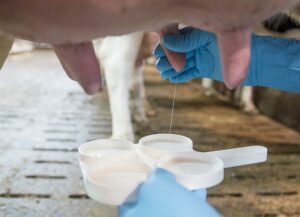Nuria García
Cows select plants while grazing, and this same behavior is also observed when fed total mixed rations (TMR). They prefer small-sized particles, such as grain over long fiber, and it is this behavior that can cause cows to receive unbalanced energy diets, and TMR refusals after sorting which may have lower nutritional value.
The intake of fiber below its optimum and higher amounts of easily fermentable carbohydrates can result in subacute ruminal acidosis, while the rations deficient in energy may induce sub-clinical ketosis. Both metabolic disorders are very common in many dairy farms.
Based on the hypothesis that the behavior of feed selection by cows is associated with a higher incidence of inconsistent energy intake, an experiment was conducted and published in the Journal of Dairy Research. The experiment compared the main metabolic metabolic disorders on farms where the feeding behavior of cows was observed or not.
Blood and urine samples were obtained from 526 clinically healthy cows, from 22 Hungarian farms, belonging to one of the following production groups:
- Fresh cows: (1-7 days postpartum; n = 74)
- Cows at the beginning of the lactation: (8-30 days postpartum; n = 230)
- Cows at the peak of the lactation: (60-100 days postpartum; n = 222)
Sample collection was done at 3-5 h after the distribution of the morning feed to measure the plasma concentration of β-hydroxybutyric acid (BHB) and net acid excretion (NAE) in urine. Subclinical ketosis was considered if the plasma concentrations of BHB acid were greater than 0.8 mmol/l, and subclinical acidosis when the NAE in urine was less than 100 mmol/l.
Feed selection was determined based on the differences between the TMR fractions collected with the Penn State particle separator between the distributed ration and the refusals.
At the time of distribution of the morning TMR (between 5:00-6:00h), approximately 1-1.5 kg of the TMR was collected from the feed bunk from each production group (mixing handfuls from 4-6 sampling points). The TMR samples were fractionated with the Penn State Particle separator (three sieves).
Current recommendations suggest that 2-8 % of the TMR sample should appear in the upper sieve (19 mm in sieve opening diameter, so it retains large particles size > 19 mm), 30-50% in the medium sieve (sieve diameter of 8 mm, so it retains medium-sized particles between 8-19 mm), 10-20% in the lower sieve (opening diameter is 4 mm, so it retains particles of small size between 4-8 mm) and 30-40% in the bottom tray (smaller particles of a size < 4 mm).
The same sampling and fractionation procedures were repeated with the feed refusals, which were collected between 12:00 and 13:00 h, 6-8 h after the distribution of the feed and immediately before sampling.
If the weight of any of the TMR fractions showed a difference of less than 5% between the distributed and refusal feed, it was assumed cows were selecting.
Selective feeding behavior
The results showed that the proportions of feed before and after feeding observed in the medium and lower sieves did not differ significantly in any of the samples studied. However, the proportion of the smaller particles fraction in the refusals was considerably lower, while the proportion of the larger particles increased in the groups of 12 farms.
Considering the criterion mentioned above, all production groups on the 12 farms were identified as groups of animals selecting feed and the groups from the other 10 farms as groups that did not select feed. It was observed that the selection behavior in all farms was in all or none of the groups studied, suggesting that this behavior was the result of the characteristics of the diet and feed management of the farms.
Relationship of the of the selective feeding behavior with different pathologies
In addition, sorting behavior was associated with risk of ketosis, with BHB acid between 0.6 and 0.2 mmol/l in cows that calved recently or in early lactation, which was higher in the groups that presented sorting behavior.
Mean concentrations of NAE in urine did not differ significantly with feed selection in any of the groups, except in open cows, where it was 73 mmol/l lower when this behavior was observed.
The average milk production in early lactation and in high production cows that sorted and those who did not, was numerically different, but not significant.
This study shows that the preference for smaller particles makes the nutritional value of the dry matter they eat no to be optimal. Thus, the amount of physically effective neutral detergent fiber they ingest is reduced, decreasing chewing activity and increasing the amount of fermentable carbohydrates in the rumen, which increases the risk of subacute ruminal acidosis.
Conclusion
In conclusion, the composition and homogeneity of the TMR are key factors in the nutrition of dairy cows, although ketosis and subclinical acidosis are multifactorial metabolic disorders that can occur independently of feed selection.
Reference
Jurkovich V, Könyves L and Bakony M. 2019. Association between feed sorting and the prevalence of metabolic disorders in Hungarian large-scale dairy herds. Journal of Dairy Research 86, 162–164.
© 2021 Dellait Dairy Knowledge Center. All Rights Reserved.









